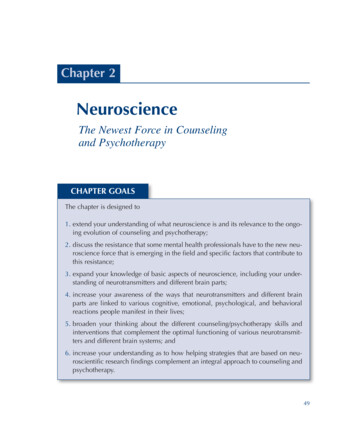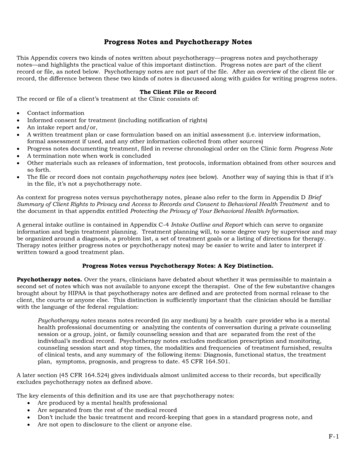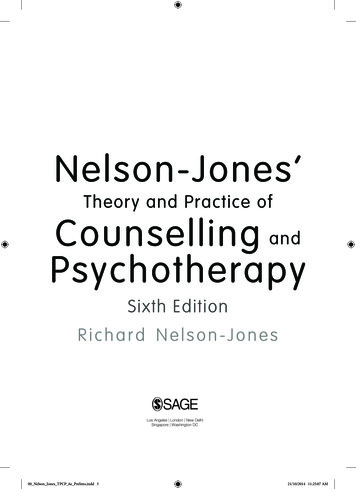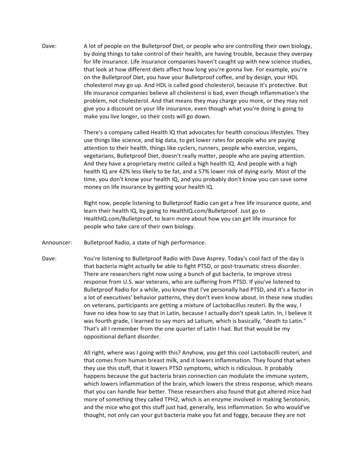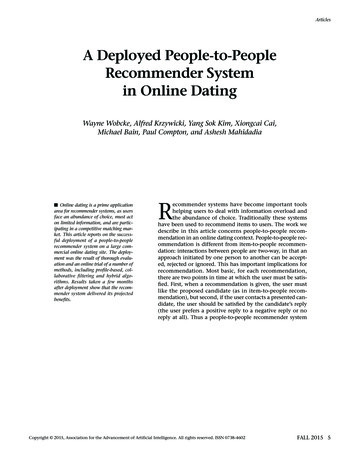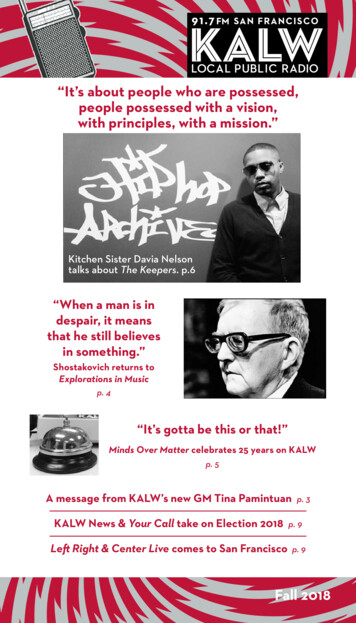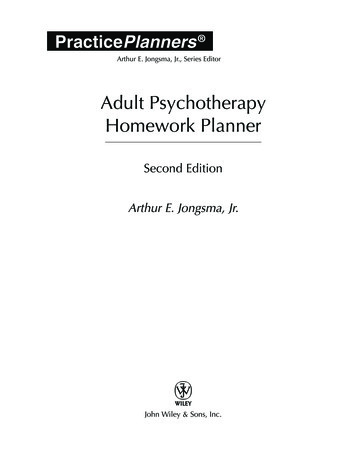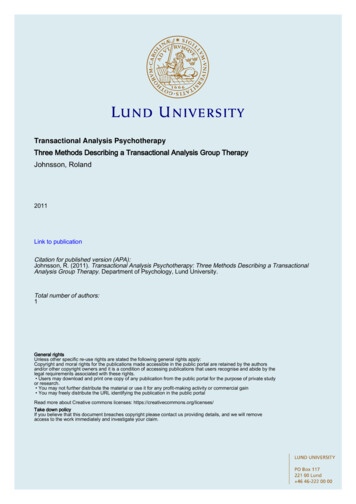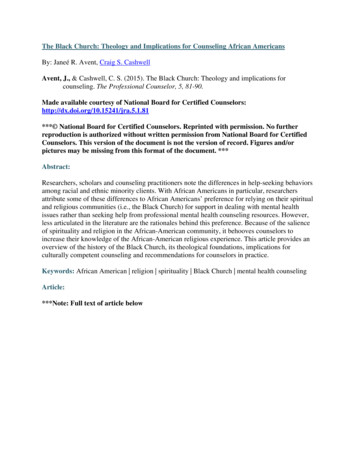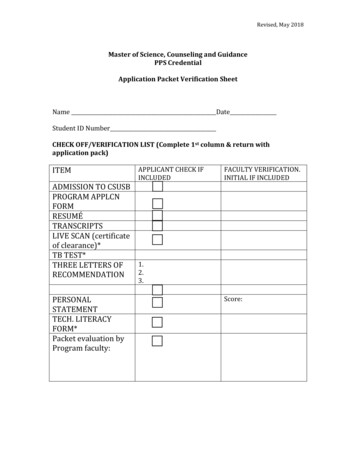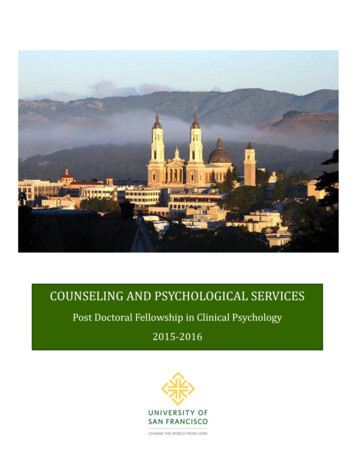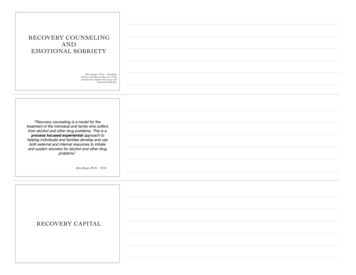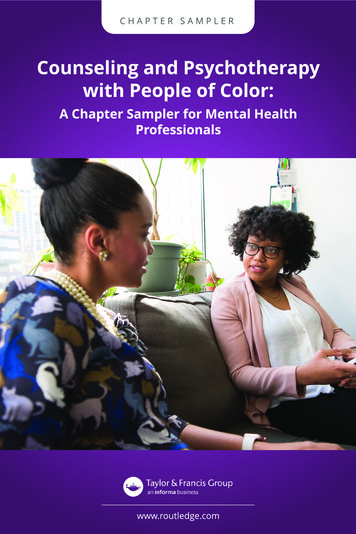
Transcription
CH A P T ER SA M P L ERCou n selin g an d Psych ot h er apyw it h People of Color :A Ch apt er Sam pler f or M en t al Healt hPr of ession alswww.routledge.com
Cont ent s1. Oppression and Ment al Healt hBy Jason D. BrownFrom Anti-Oppressive Counseling andPsychotherapy: Action for Personal and SocialChange2. Assessm ent and Diagnosis of RaceBased-St ressWith Monica M. Johnson and MichelleL. MeltonFrom Addressing Race-Based Stress in Therapywith Black Clients: Using Multicultural andDialectical Behavior Therapy Techniques3. An Int egrat ive Approach t oUnderst anding and Treat ingDisordered Eat ing in AfricanAm erican Wom enBy Carolyn Coker RossFrom Treating Black Women with EatingDisorders: A Clinician's Guide4. The Racial Com plexWith Fanny BrewsterFrom The Racial Complex: A Jungian Perspectiveon Culture and Race5. Dying t o Get Out : Challenges int he Treat m ent of Lat in Am ericanMigrant s Fleeing ViolentCom m unit iesWith Ricardo Ainslie, HannahMcDermott, and Crystal GuevaraFrom Psychoanalysis in the Barrios: Race, Class,and the Unconscious6. Counseling Muslim Couples andFam ilies in t he Unit ed St at esWith Khalid A. AlfallatahFrom Intercultural Perspectives on FamilyCounseling20% Discount AvailableYou can enjoy a 20% discount across our entire range of Routledgebooks. Simply add the discount code KM L20 at the checkout.Please note: This discount code cannot be combined with any other discount or offer and is only valid on print titles purchaseddirectly from www.routledge.com.
1OPPRESSION ANDMENTAL HEALTHThis chapter introduces the topic of global inequality and presents some evidence of its existence with social, economic and political examples across Canadaand the United States. A colonial analysis of historical relations between originalIndigenous peoples and European immigrants to North America explores thebeginnings of oppression. The arrival and establishment of settler societies represented the views of white, European, Christian males. This analysis illustratesconcepts of diversity, privilege and disadvantage. It is followed by an introductionto psychological studies of stigma, prejudice and micro-aggressions.Why is social inequality relevant to professional counseling and psychotherapy? We live in an unequal society. Each of us is born within a hierarchy. Position in the hierarchy is advantageous to some and disadvantageous to others.Social positions have a substantial lifelong effect on individuals.Inequality produces oppression. Problems exist at both the structural leveland the personal level as well as in between. Social problems manifest as personal problems (e.g. gender differences in employment position and income).Personal problems manifest as social problems (e.g. employment and incomeopportunities and outcomes differ by gender).Oppression is reflection of a group’s and individual’s status relative to others. It puts one member of a particular group at a distinct advantage overmembers of another group. Differences exist in power, influence and control.These differences manifest as unequal opportunities and unequal outcomes.Forces of oppression are structural (e.g. market, globalization, colonization)and reflected in policies and practices between nations. These forces arenational (e.g. government policy, ownership, participation) and reflected in
6 Oppression and Mental Healthpolicies and practices within nations. The forces are also local (e.g. location,services, capital) and reflected in policies and practices within communities.These forces are personal (e.g. esteem, agency, identity) and reflected in personal meaning.Counseling and psychotherapy focus on individuals. The practices operatefrom the basis that problems exist or are accessible within the individual.Such problems manifest as imbalances, excesses or deficiencies of knownproperties of the mind.An anti-oppressive (AO) perspective broadens the view of individuals to theforces that exist outside and recognizes the profession and the professionalpositioned within systems of oppression.From an AO perspective, mental health is personally and structurally determined. Personal problems manifest as imbalances, excesses or deficiencies ofknown aspects of a community or society.AO Counseling and Psychotherapy (AOCP) locates a portion of the responsibility on context that can be influenced by a collective. AOCP views interpersonal circumstances and the social context as legitimate targets for change.The professional and client engage in both internal and external change toaddress the problem.Chapter OutlineInequality 7Economic 7Social 9Political 10Positions Against Social Inequality 10Legacies of the Settler Societies 10Race and Ethnicity 11Gender and Sexuality 12Employment and Ability 12Age 12Religion 13Colonialism Today 13Social Privilege 13Oppression 15Stigma and Prejudice 16Micro-Aggressions 17Conclusion 18
Oppression and Mental Health7Web Links 37Key Terms 37Discussion Questions 23InequalityIn 2017, Oxfam reported that “8 men owned the same wealth as the pooresthalf of the world”, and Credit Suisse reported that those in the top 1% of globalwealth together owned more than the rest of the globe (Anand & Segal, 2017).Today, the United States holds 33% of global wealth, while Canada holds 3%.There is clear evidence of global economic inequality. The country one is bornin and the income distribution of that country are highly predictive (Milanovic,2015). However, differences within nations are widening to a greater extent thanthe gaps between nations (Milanovic, 2016).Within nations, an index known as the Gini coefficient reflects the incomedistribution. It is one of the most widely used measures of inequality. On thismeasure, a score of 0 represents maximum equality and 100 represents maximuminequality. In Canada, the Gini coefficient for 2010–2015 (United Nations, 2016)was 33.7 and the US was 41.1 (Bogliacino & Maestri, 2016). According to theWorld Bank (2015), the nation with the highest Gini, of 176 ranked nations, wasSouth Africa at 63.4 and the nation with the lowest Gini was Ukraine at 25.5.Internationally, Canada ranked 68th and the United States 117th, reflecting amajor gap between their least and most wealthy citizens.The relationship between inequality and social problems is linear and positive, such that the greater the inequality, the greater the indices of violent crime,obesity, mental illness, imprisonment and teen births (Wilkinson & Pickett, 2010).With greater equality, there is a greater sense of cohesion, trust, cooperation andsocial stress (Wilkinson & Pickett, 2017).The connections between low population and personal health status are evident in developmental trajectories (Pless, Hodge, & Evans, 2017), as well as withinregional and local communities with higher concentrations of risk factors (Fazel,Geddes, & Kushel, 2014). There is ample evidence that policies associated withimproved access to education, health care, housing, employment and other services within disadvantaged or underserviced areas and populations have a positiveleveling effect (Allen, Balfour, Bell, & Marmot, 2014). In the sections that follow,connections between economic, social and political inequality are described.EconomicThe Vertical Mosaic (Porter, 1965) was coined to reflect the prominent layers ofsocial arrangement.While the book was written 50 years ago, the concept remainsand is the subject of discussion and debate. Recently (Porter, 2015), scholars have
8Oppression and Mental Healthwritten about the vertical mosaic in relation to gender and race inequality, citizenship and social justice as well as social class and power. To illustrate, povertylines in Canada and the United States reflect significant differences between individuals and families along the continuum from least to most wealth.Low Income Cut Offs (LICO) in Canada are relative measures of povertythat identify the threshold at which families are spending more than 20% oftheir income than the average on food, clothing and shelter. They are calculatedby number of people in a family and by community size. According to theLICO measure, there are several demographic groups that are overrepresentedand therefore at risk for poverty (Canada, 2010; Tweddle, Battle, & Torjman,2015):1.Children 2.Women 3.42.8% of all unattached25% of adults in urban families27.5% under 15 with family63% for 16–24 yearsPeople with disabilities 6.58.1% of 18–24 years31.6% of 45–54 years39.3% of 55–64 yearsIndigenous peoples 5.9.9% nationally29% of all unattachedearn 71.4% of what full-time men earn on averageUnattached adults 4.9.1% nationally23.4% of lone parent39.3% in recent immigrant familieslower average income, 28,503 vs. 37,309 (national average)43.9% 15–64 NOT in labor force vs. 19.8% (national average)Recent immigrants 32.6% of families58.3% of unattached54.7% of refugees
Oppression and Mental Health9The US poverty line is based on pre-tax income and proportion spent on costof a minimum diet, adjusted annually for inflation and reported based on familysize, composition and age. The US (Department of Health and Human Services,2015) poverty rate is quite restrictive but still includes 14.5% (45.3 millionpeople). The child poverty rate was 19.9%: for African-American children 36.9%,Hispanic 30.4% and white children 10.7%.Nearly half of all female-headed lone-parent families (45.8%) lived in poverty.Working age individuals with and without disabilities had discrepant povertyrates of 28.4% vs. 12.4%.Women were 35% more likely to live in poverty than men.19% of immigrants vs. 13.5% non-immigrants live in poverty.Among 18–44-year-olds, 15.3% of males and 21.1% of females live in poverty, with rates increasing among those who identify as gay or lesbian, at20.5% and 22.7%, higher for individuals who identify as bisexual, at 25.9and 29.4%, compared to 20.1% and 21.5% for those who do not identify asa member of the LGBTQ2 community.About 40% of homeless youth identify as LGBTQ2 (Macartney, Bishaw, &Fontenot, 2013).In the UK, poverty rates for Muslims are 50%, relative to those who are Jewish (13%), Sikh (27%), Hindu (22%), Anglican (14%) or Catholic (19%), with18% as the national average (Heath & Li, 2015).SocialSocial indices of inequality are reflected in victimization statistics. In Canada (Statistics Canada, 2017), hate crimes occurred most frequently based on race orethnicity targeting—in order of occurrence: Black, East Asian and South Asianindividuals. Religion was the second most frequent target of hate crimes, withindividuals who were Jewish or Muslim most frequently the targets. Sexual orientation was the third most frequent target of hate crime. In the United States, hatecrimes reported to police, in order of frequency (Federal Bureau of Investigations,2016), occurred on the basis of race/ethnicity, religion, sexual orientation, genderidentity and, finally, disability.In another illustration of social inequality, approximately 70% of incidentsof abuse of woman go unreported, and of those that are, one-third are sexualassaults and beatings. Women with disabilities in Canada are 1.4 more likelythan women without a disability to experience abuse. In 2013 (US), the rate ofserious violent victimization for persons with disabilities (14 per 1,000) was morethan three times higher than the age-adjusted rate for persons without disabilities(4 per 1,000).
10 Oppression and Mental HealthPoliticalPolitical indices of inequality are reflected in voting behavior and representationof elected officials. In the United States, voting rates vary by ethnicity. In the lastpresidential election (2016), 65.3% of eligible white voters voted, 59.6% of Blackvoters and 47.6% of Hispanic voters (US Census, 2017). Canada is closer to thegoal of building a diverse parliament that represents its population. A cabinet ratioof 48.3% women, 16.1% visible minorities and 6.5% Indigenous comes close tomatching a Canadian population that was 50.9% women, 22.3% visible minoritiesand 4.9% Indigenous (Wherry, 2015).Positions Against Social InequalityAn argument upon which this text is based is that unequal opportunities andoutcomes diminish population and personal mental health. This context creates conditions in which mental health problems are more likely to be triggered,exacerbated and maintained. Three additional arguments against inequality arereflected in the following moral, economic and political positions.A moral argument against inequality is that it is unfair and thereforeunjust (Marquez, 2018). This is a value position that begins with the idea that nolife is worth more than any other life. However, unequal life chances, unequalopportunities and unequal outcomes exist and must be addressed.An economic argument against inequality is that few have the meansto purchase enough to keep the economy functioning. According to the OECD(2014), economic growth decreases when inequality increases (Dabla-Norris,Kochhar, Suphaphiphat, Ricka, & Tsounta, 2015). The poorest 40% of the population are most affected when inequality rises. Greater inequality leads to less education by those at the lower end of the distribution, which diminishes economicpotential.A political argument against inequality is that it reduces political interestand involvement in elections. The most well off do not have the voting numbersto continue to lead democratic systems. However, those who are not representedin political office and have no candidates may choose not to vote.Legacies of the Settler SocietiesSocial inequality in the United States and Canada is reflected in colonial historyfollowing the arrival of Europeans and creation of settler societies. At the time ofcontact, Europeans arrived within nations that were self-sufficient and connectedto the land. It has been noted thatarchaeological evidence is mounting to the point where it can now be arguedwith growing conviction, if not absolute pro
with People of Color: A Chapter Sampler for Mental Health Professionals www.routledge.com. 20% Discount Available You can enjoy a 20% discount across our entire range of Routledge books. Simply add the discount code KML20 at the checkout. Please note: This discount code cannot be combined with any other discount or offer and is only valid on print titles purchased directly from www.routledge .
